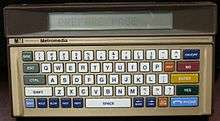Telelocator Alphanumeric Protocol

Telelocator Alphanumeric Protocol (TAP) is an industry-standard protocol for sending short messages via a land-line modem to a provider of pager and/or SMS services, for onward transmission to pagers and mobile phones.[1][2]
TAP, initially known as Motorola Page Entry (PET) was adopted in September 1988, by the Personal Communication Industry Association. TAP defines an industry standard for sending alphanumeric messages to pagers.[3]
TAP was also known as IXO protocol.[4] Originally, devices like the IXO Device were used to send Alphanumeric Pages using TAP. Later, Motorola would create a similar device called the AlphaMate.
TAP Communication Protocol
The standard protocol is ASCII with XON/XOFF flow control, using a 10-bit code (1 start bit, 7 data bits, even parity, 1 stop bit). No echo shall be employed in full duplex mode.[5]
See also
References
- ↑ http://www.verisign.com/stellent/groups/public/documents/data_sheet/002641.pdf
- ↑ http://dartware.com/support/docs/web/Content/06-Notifiers/06-01-ConfiguringNotifications/AlertViaCellPhone.htm
- ↑ http://www.tap-ixo.info/
- ↑ http://www.tap-ixo.info/
- ↑ Telocator Alphanumeric Protocol (TAP), Version 1.8, February 4, 1997
External links
- Directory of TAP Dialup Numbers from avtech.com
- Directory of TAP Dialup Numbers from notepage.net
- Universal TAP Gateway from tapgateway.com
- (http://www.picell.com/fileadmin/documents/tap_v1p8.pdf